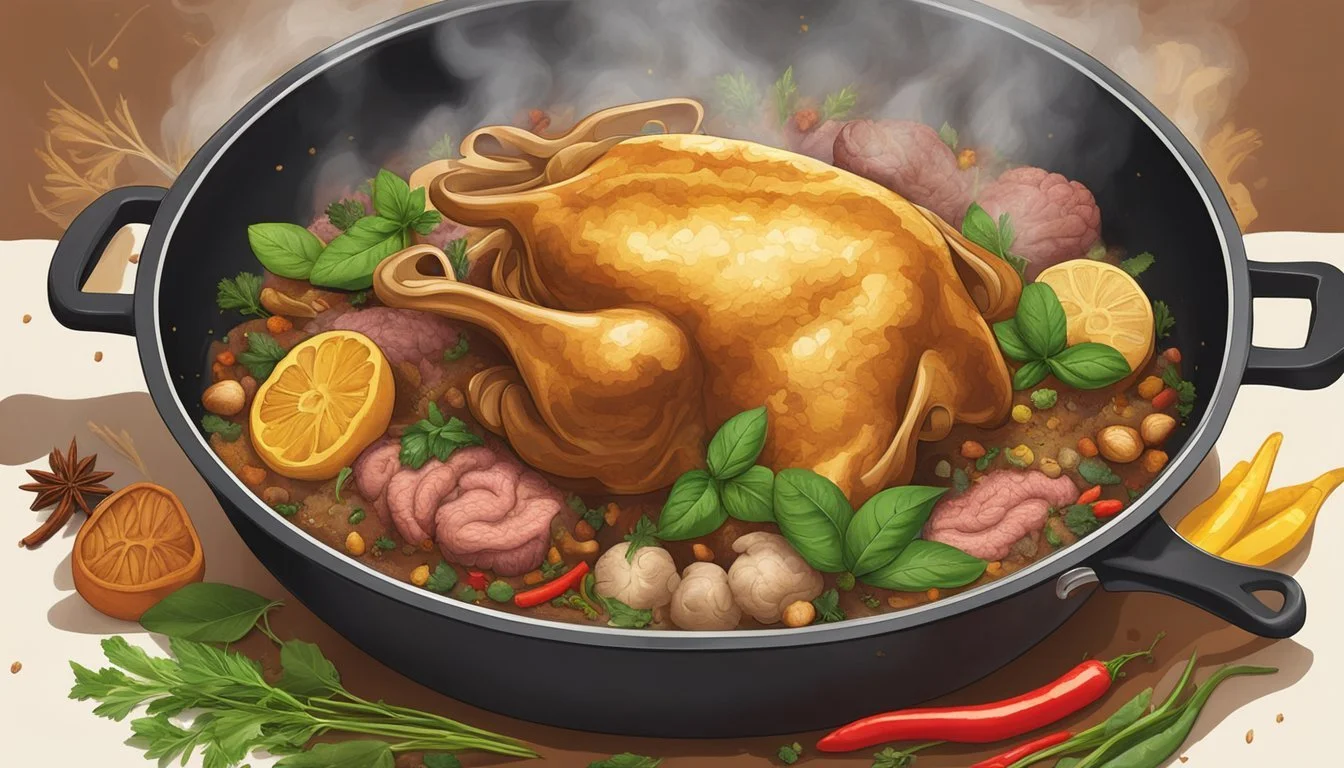Fried Cow Brain
Exploring the World of Offal Cuisine
Fried cow brain is a dish that encapsulates the adventurous spirit of culinary explorers and the timeless tradition of using every part of the animal – a practice known as offal consumption. This delicacy is particularly popular in Egypt, where street vendors and restaurants serve it crispy on the outside while keeping the inside tender and hot. Its preparation is simple yet requires skill; cow brains are sliced, breaded, and deep-fried, turning an often-overlooked ingredient into a sought-after treat for those willing to step beyond mainstream cuts of meat.
Offal, the term for organ meats, has long been an integral component of many cultural cuisines, bearing testament to a deep-seated respect for the animal by utilizing its various parts. The offal-eating tradition embraces a wide array of organs, with brain being just one of the many options that provide unique flavors and textures. Across the globe, these dishes vary greatly in preparation and seasoning, yet they all share a common thread: a commitment to celebrating the full culinary potential of animals.
In Texas, for example, the array of offal stretches from cow tongue tacos to crispy fried chicken livers, underscoring the state's rich culinary heritage. These specialties highlight the versatility of offal and showcase the many ways in which a single ingredient can be transformed to suit local tastes and preferences. Whether in the context of Egyptian street food or Texan comfort dishes, fried cow brain stands out as a bold expression of cultural identity and a testament to the ingenuity inherent in culinary traditions worldwide.
The Rich Tradition of Offal in Global Cuisine
Offal, encompassing a diverse range of organ meats, has held a vital role throughout history and across different cultures. This section explores the historical significance, cultural importance, and the variety of global dishes that celebrate offal as a favored delicacy.
Offal Through History
Historically, the consumption of offal can be traced to times when communities practiced nose-to-tail eating, leaving no part of the animal to waste. Organ meats, including brain, were valued for their nutrient density. For example, cattle brains were often prepared as a rich, flavorsome dish. This tradition of consuming animal organs is observed across various time periods and continents, with each era unfolding new methods of preparation and presentation.
Cultural Significance of Organ Meats
Organ meats hold a special place in the hearts and traditions of many cultures worldwide. In Turkish cuisine, for example, dishes like kokoreç (lamb intestines wrapped around seasoned offal) showcase the blend of flavor and texture unique to offal. Events like World Testicle Cooking Championship highlight the global interest in offal, celebrating these ingredients through festive cooking competitions.
Notable Organ Meats:
Brain: Served fried or in pâtés
Heart: Often grilled or made into stews
Liver: Commonly sautéed with onions
Global Dishes Featuring Offal
Variety meats feature in an array of global dishes that exhibit the innovation and resourcefulness of cultures in using every part of the animal. In addition to Turkish delights, regions like Scandinavia have their own version of offal dishes like heart and lung pâté. The consumption of sheep’s head is a traditional practice in places like Iceland and South Africa, reminiscent of the breadth of offal’s culinary reach.
Dishes From Around the World:
Turkish Kokoreç
Scandinavian Heart and Lung Pâté
South African Sheep's Head
Incorporating fish offal is also prevalent in various culinary traditions, elevating the sustainable ethos of utilizing all parts of the fish. These varied offal dishes demonstrate a rich and enduring history within global cuisine.
Understanding Offal: Types and Terminology
This section explores the distinct category of meat known as offal, differentiating it from standard meat cuts and detailing the various organ meats that fall under this term.
Defining Offal
Offal refers to the organs and entrails of a butchered animal that are consumed as food. This term encompasses a wide variety of organ meats considered delicacies in many cultures. Offal can include parts such as brains, liver, kidneys, tongue, tripe (the stomach lining of ruminants), and more exotic items like spleen, testicles, and lungs.
Offal vs. Standard Cuts of Meat
Offal is distinct from standard cuts of meat which typically refer to muscle tissue. Standard cuts are the familiar steaks, chicken breasts, or pork chops (What wine goes well with pork chops?) found in many Western meals. Organ meats, on the other hand, are often richer in nutrients, containing higher concentrations of certain vitamins and minerals compared to muscle meats.
Common Types of Offal
The category of offal includes a diverse array of animal parts. Below is a list of common types of offal and their typical uses:
Brains: Often fried or used in various cuisines as a rich, creamy ingredient.
Heart: Used in dishes such as stews or grilled in some culinary traditions.
Liver: Frequently cooked with onions or made into pâtés; a high source of iron and vitamins.
Kidneys: Commonly used in pies or sautéed; lamb kidneys are especially prized.
Tongue: Often pickled, boiled, or served in slices.
Tripe: Cooked in soups or stews, particularly in Latin American and Asian dishes.
Lungs: An ingredient in traditional dishes like haggis.
Intestines: Typically cleaned and used as sausage casings or in dishes like chitterlings.
Spleen: Less commonly consumed but found in some traditional recipes.
Testicles: Known as 'Rocky Mountain oysters,' often battered and fried.
Oxtail: Braised to make rich soups and stews.
Bone Marrow: Used as a spread or to add depth to broths and stews.
Sweetbreads: A term for the thymus and pancreas, typically from veal or lamb, prized for their delicate texture when cooked.
Cow’s Stomach: Used in dishes like the Italian 'trippa.'
Each type of offal offers unique flavors and textures and is integrated into the culinary heritage of various cultures around the globe.
Nutritional Profile of Cow Brain and Offal
The nutritional profile of cow brain and offal is rich with essential nutrients, including protein, minerals like iron and zinc, and a variety of vitamins, although they are also high in cholesterol.
Health Benefits of Offal
Offal, the collective term for organ meats, is a source of dense nutrients. As a component of the diet, these meats provide high-quality protein and are abundant in essential amino acids. Nutrients such as folate, vitamin B12, and fat-soluble vitamins are present in substantial quantities. Iron, magnesium, selenium, and zinc are also found in offal, contributing to a variety of bodily functions, from oxygen transport to immune defense.
For example, a 1 oz serving of chicken liver contains:
Water: 18.8g
Energy: 47.1 kcal
Protein: Ample amounts
Rich in vitamins like A, D, E, and K
Cow Brain Nutritional Information
The cow brain is a unique offal item with a specific nutritional makeup. A cow brain is particularly high in cholesterol but also offers certain omega-3 fatty acids and other beneficial nutrients. A serving of cow brain (approximately 3.5 ounces or 100 grams of cooked beef brain) contains about 2000 milligrams of cholesterol. This underscores the importance of consuming such items in moderation within a well-balanced diet.
Despite the high cholesterol content, cow brain and similar offal meats can offer vitamins and minerals that might be scarce in muscle meats. Concentrations of certain nutrients in cow brain include:
High cholesterol
Omega-3 fatty acids
Various vitamins and minerals
Both cow brain and other offal products should be considered for their nutrient value, contributing to dietary diversity and nutrient intake, especially in cultures that esteem these as culinary delicacies.
Preparing and Cooking Fried Cow Brain
In this section, precise steps and techniques are emphasized to ensure that the fried cow brain is both safely prepared and rich in flavor. Attention to detail in ingredient selection, preparation, and cooking methods is crucial for creating this unique offal delicacy.
Selecting Quality Ingredients
One must source the highest quality brains, such as beef or lamb, ensuring they are fresh and devoid of any unpleasant odor. Sweetbreads are an alternative for those preferring a different taste profile. Freshness is critical, as offal can degrade faster than muscle meats.
Beef or Lamb Brain: Fresh, no discoloration
Eggs: Fresh, for battering
Flour: Unbleached, for dredging
Spices: Cumin, black pepper, and salt, essential for the seasoning blend
Safe Handling and Preparation Procedures
The brain should be washed thoroughly under cold water to remove any blood residue. It is then essential to soak in water with vinegar or lemon juice, which helps in firming up the brain tissue. Careful removal of any membrane ensures a delicate final texture.
Soak: In vinegar or lemon water for firmness
Clean: Remove membranes carefully
Cooking Techniques for Cow Brain
The brain must be pre-cooked by simmering in water prior to frying; this ensures that it is cooked through and safe for consumption. After simmering, it should be cut into pieces and cooled before breading. Deep-frying in hot oil then achieves a crisp exterior without overcooking the delicate interior.
Simmer: Roughly 6 minutes
Deep-fry: Oil at 350°F (177°C) until golden
Seasoning and Flavor Enhancement
A balanced mix of spices, including cumin, black pepper, and salt, should be used to enhance the flavor of the meat. Herbs such as sage or parsley can contribute an aromatic depth to the dish. Onions and garlic, either incorporated into the breading or as a garnish, can add both texture and a complementary flavor profile.
Spices: A blend of cumin, black pepper, and salt
Herbs: Sage and parsley, finely chopped
Extras: Onions, garlic, or a dash of lemon juice for brightness
Serving Suggestions for a Delectable Experience
When preparing fried cow brain, pairing it with the right accompaniments can elevate this offal delicacy to new heights. Choices of sides and thoughtful presentation can turn the dish from mere novelty to a refined appetizer.
Accompaniments and Sides
The rich texture and flavor of fried cow brain, especially when prepared to a crispy finish, complements certain sides and flavors. Here's a considered selection:
Rice: A bed of fluffy rice can help to balance the dish, providing a neutral base for the creamy texture of the brain.
Potatoes: Roasted or mashed potatoes offer a hearty side that pairs well with the offal's delicate taste.
Spicy Sauces: A spicy sauce can cut through the fattiness and enhance the dish's flavor profile.
Salad with Lemon Dressing: A light salad dressed with lemon provides acidity that refreshes the palate.
Crisp Vegetables: Sliced bell peppers or cucumbers offer a crunchy counterpoint.
Presentation Ideas
First impressions are crucial. Presenting fried cow brain with creativity can significantly impact the dining experience:
Serve in a clean, white dish to allow the golden-brown hue of the fried brain to stand out.
Garnish with fresh herbs such as parsley for a pop of color and a hint of freshness.
If serving as an appetizer, consider using small individual plates or casings, allowing each guest their own neatly presented tasting portion.
For a rustic touch, present the brain on a wooden board alongside wedges of lemon and a side of bright, pico de gallo-like tomato salsa.
By considering these serving suggestions, fried cow brain can shine as a centerpiece of culinary exploration into the world of offal.
Exploring Related Offal Delicacies
Offal, or organ meats, present diverse flavors and textures beyond the fried cow brain. They are not just a culinary novelty but also a tradition deeply embedded in various cultures.
Beyond Cow Brain: A Variety of Offal Choices
When one ventures beyond cow brain, they encounter a rich collection of offal choices, each with its unique taste and culinary function. Lamb sweetbreads, highly regarded for their tender texture, are a delicacy in many cuisines. Beef heart and liver, known for their robust flavors, are commonly consumed and have nutritional benefits due to their high protein and mineral content. Turkish cuisine takes pride in its use of offal, where dishes may feature lamb kidneys, infused with a mix of spices and herbs, as a staple.
Beef Offal:
Beef Liver: Prominent for its iron-rich profile.
Beef Tongue: Sought after for its tenderness and taste.
Beef Cheeks: Valued for their marbled texture and deep flavor.
Pork and Lamb Offal:
Pork Liver: Often transformed into savory liver pâté.
Lamb Kidneys: Delicate when cooked properly, paired with sharp vinegar.
Organ meats like liver, kidneys, and even tongue, can be prepared in myriad ways, from simple grilling to incorporation in complex dishes with layered seasonings and accompanying components such as connective tissue, which provides contrasting textures.
Pairing Offal with Other Foods
One may enhance their culinary experience with offal by pairing these meats with complementary flavors and ingredients. For example, the metallic taste of liver harmonizes well with the tanginess of vinegar or the sweetness of caramelized onions. Offal flavors can range from subtle to assertive and are often balanced with acidic or spicy elements.
Conventional Pairings:
Beef liver with onions.
Lamb kidneys with mustard sauce.
Complex Pairings:
Sweet and sour profiles using fruits or sweet glazes to offset the robust flavors of offal.
Offal meats with a variety of herbs, from parsley to rosemary, to elevate the dish.
Whether prepared as the main ingredient or used to complement other elements of a dish, offal presents an opportunity for cooks to exhibit their culinary prowess, offering a gastronomic journey that extends well beyond the conventional meat cuts.
Ethical and Sustainable Considerations
When embarking on a culinary journey through offal delicacies such as fried cow brain, it is crucial to address both ethical and sustainable concerns. This section will explore how the consumption of organ meats fits within responsible eating practices and the broader food ethics discussion.
The Nose-to-Tail Philosophy
Nose-to-tail eating is a practice that reduces waste by utilizing all parts of an animal, from common cuts to the unseen body parts often discarded, such as brain and other offal. Proponents argue that if animals are being raised for consumption, it is respectful to use as much of them as possible, honoring their life and reducing waste. The inclusion of organ meats like brain in culinary traditions is a testament to this philosophy. Brain, as offal, is a nutritious element of the animal and represents a sustainable approach to meat consumption when used effectively.
Addressing Ethical Concerns with Offal Consumption
The consumption of organ meats, including brain, raises ethical questions regarding animal welfare and the respectful treatment of animals. Consumers are increasingly aware of how their food choices impact the environment and animal well-being. Ethical concerns specific to offal include:
Sourcing Transparency: Knowing where and how the animals were raised and processed is essential. This includes ensuring that animal parts like the brain come from facilities that uphold high standards of animal welfare.
Health and Safety: Given that offal such as brain can carry risks if not handled properly, ethical consumption involves rigorously adhering to food safety standards to prevent diseases.
Cultural Sensitivity: It is important to approach culinary traditions involving organ meats with respect and understanding of their significance within different cultures.
Engaging in the consumption of offal delicacies like fried cow brain requires a thoughtful balancing act between culinary exploration and conscientious eating practices. Observing the nose-to-tail philosophy can celebrate the full spectrum of meaty flavors while maintaining a sustainable and ethical approach to animal products.
Conclusion
Fried cow brain, an offal delicacy, stands testament to culinary diversity and innovation. Through its preparation and consumption, it bridges cultural traditions and taste experiences. This dish's roots reflect a longstanding human practice of using every part of the animal, mirroring a philosophy of respect and sustainability.
In culinary circles, the dish elicits both intrigue and admiration for its delicate texture contrasted by a crispy exterior. Its preparation involves meticulous cleaning, slicing, and a careful frying process, highlighting the skill involved in offal cuisine. The dish is more than a mere novelty; it plays a significant role in the cuisines of various countries, incorporating local flavors and cooking traditions.
In Egypt, vendors masterfully transform cow brains into a street food staple. Similarly, in French and Turkish cuisines, they have secured a place both in homes and in gourmet restaurants. In contrast, Sichuan cuisine offers a spicy hot pot variant, showcasing the brain's versatility.
One cannot ignore the nutritional aspects, as cow brains are rich in nutrients essential for the human diet. However, it is essential to consume them in moderation and be mindful of dietary restrictions and food safety regulations surrounding prion diseases.
In essence, fried cow brain exemplifies an adventurous chapter in the world of offal delights, encouraging culinary exploration beyond conventional cuts of meat. It challenges perceptions, invites discussion, and has a place in the gastronomic narrative that values the less trodden path.
Appendix
In this appendix, readers will find a curated list of resources for further exploration into the world of offal delicacies, along with a glossary of key terms. These tools aim to enhance understanding and provide a basis for additional research.
References and Further Reading
Jennifer McLagan: An acclaimed author who has written extensively on the subject of preparing and enjoying odd bits of animals, notably in her book "Odd Bits: How to Cook the Rest of the Animal."
"Odd Bits": This book is a comprehensive guide to cooking unconventional animal parts, offering practical advice, recipes, and the cultural significance of dishes like fried cow brain.
Norwegian Pâté: For those curious about European offal preparations, investigating traditional Norwegian pâté recipes can provide insight into regional approaches to organ meats.
Glossary of Terms
Offal: The organs and entrails of a butchered animal, often considered by-products and used in a variety of dishes worldwide.
Pâté: A paste, pie, or loaf filled with a forcemeat that often includes liver and fat, plus spices and other flavorings.
Brain: The organ of an animal considered a delicacy in many cultures, can be prepared in numerous ways including frying.








